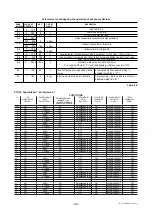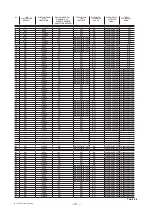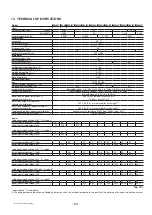
-
54
-
© STULZ GmbH, Hamburg
-
54
-
11.2 Table of alarms and signals
code displayed
con-
troller
remote
term.*
causes
solution
action
reset
display (H)
alarm
relay
reset
relay (H)
H
P
H
EH
E102
over-current at the electrodes;
probable electrode malfunction
or water conductivity tempo-
rarily too high (especially when
starting after a short stop)
1. check the operation of the drain
electrovalve
2. check the seal of the fill electrovalve
when not energised
3. drain part of the water and re-start.
total
shut-
down
total
shut-
down
not
available
active
not
available
EL
E103
power not available; with the
machine on no steam is
produced
1. with the machine off and disconnected
from the mains, check the internal
electrical connections.
total
shut-
down
total
shut-
down
not
available
active
not
available
EC
E105
high supply water conductivity 1. check limit set for b6;
2. turn the machine off and clean
the water conductivity measuring
electrodes;
3. if the problem persists, change
the source of supply water or
install a suitable treatment system
(demineralisation, even partial).
N.B.: the problem will not be resolved
by softening the supply water.
-
total
shut-
down
not
available
active
not
available
EP
E113
excessive reduction in
production
1. cylinder completely depleted or
water with excessive foam. Perform
maintenance on the cylinder
total
shut-
down
machine
disabled
manual
active
manual
EF
E114
no water
1. check that the fill pipe from the mains
to the humidifier and the internal pipe
are not blocked or bent and that there
is sufficient pressure (0.1-0.8 MPa,
1-8 bar);
2. check the operation of the fill
electrovalve;
3. check that the steam outlet is not
working against excessive back
-pressure, preventing the flow of water
into the cylinder by gravity;
4. check that the steam outlet pipe is not
is choked and that there are no pockets
of condensate.
total
shut-
down
machine
disabled
automatic
when water
returns (see
par. 12.2.10)
active
automatic
when
water
returns
EA
E115
excessive foam in the cylinder
during boiling
the formation of foam is generally due to
the presence of surfactants in the water
(lubricants, solvents, detergents, water
treatment agents, softeners) or an
excessive concentration of dissolved salts:
1. drain the water supply lines
2. clean the cylinder
3. check for the presence of softeners
(in this case, use another type of water
or reduce the softening)
-
signal
only
manual
active
manual
E
C
E116
drain malfunction
check the drain circuits and the correct
operation of the drain electrovalve
total
shut-
down
machine
disabled
manual
active
manual
E
C
E131
high water conductivity
pre-alarm
check the conductivity of the supply water
if necessary, install a suitable treatment
system
N.B.: the problem will not be
resolved by softening the supply water.
-
signal
only
automat.
not
active
E-
E121
high humidity in the room
(high temp. for T control)
check the operation of the probe and the
limit set for parameter P2
-
signal
only
manual
active
auto
E
_
E122
low humidity in the room
(low temp. for T control)
check the operation of the probe and the
limit set for parameter P3
-
signal
only
manual
active
auto
E
=
E124
high outlet humidity
check the operation of the outlet
probe
-
signal
only
manual
active
auto









































